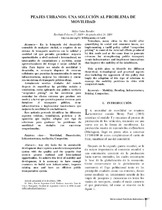Mostrar el registro sencillo del ítem
Peajes urbanos: una solución al problema de movilidad
| dc.contributor.author | Salas Rondón, Miller | |
| dc.coverage.spatial | Seccional Bucaramanga | spa |
| dc.date.accessioned | 2021-02-17T16:02:46Z | |
| dc.date.available | 2021-02-17T16:02:46Z | |
| dc.date.issued | 2009 | |
| dc.identifier.uri | http://hdl.handle.net/20.500.11912/8081 | |
| dc.description | 12 p. | spa |
| dc.description.abstract | En la búsqueda del desarrollo sostenible de cualquier ciudad, se requiere de un sistema de transporte moderno con la calidad y cantidad tal que permita garantizar: mayores oportunidades a nivel nacional e internacional, un intercambio de conocimiento y servicios, mejor aprovechamiento del tiempo y mejor calidad de vida. Para lograr ese estado de movilidad y desarrollo, es necesario disponer de recursos suficientes que permitan la construcción de nuevas infraestructuras, mejorar las existentes y contar con un sistema de transporte público eficaz. Actualmente muchas ciudades del mundo después de cuantificar las pérdidas sociales y económicas, están aplicando una política tarifaria “congestion pricing” en las carreteras para controlar los efectos externos que produce este modo y a la vez que permita generar recursos para fortalecer el transporte público, crear infraestructura e implementar innovaciones que mejoren la movilidad de sus habitantes. Este artículo pretende identificar los diferentes aspectos teóricos, tecnológicos, prácticos y de oposición que implica adoptar este tipo de soluciones para gestionar los problemas de movilidad en ciudades con carreteras congestionadas. | spa |
| dc.description.abstract | Any city looks for its sustainable development that requires a modern transportation system with the quality and the quantity that ensures greater national and international opportunities. To achieve this level of mobility and development, it is necessary to have enough resources to build new infrastructure, improve existing ones and have an efficient public transportation system. Nowadays, many cities in the world after quantifying its social and economic losses, are implementing a tariff policy called “congestion pricing" to control the external effects produced by this mode and at the same time to generate revenues for strengthening public transport, create infrastructure and implement innovations that improve the mobility of the inhabitants. This article aims to identify the different theoretical, technological and practical aspects also including the opponents of this policy that imply the adoption of this type of solutions to manage the mobility problems in cities with congested roads. | spa |
| dc.format.mimetype | application/pdf | |
| dc.language.iso | spa | |
| dc.publisher | UPB | spa |
| dc.relation.ispartof | Puente. Revista Científica | spa |
| dc.rights | Attribution-NonCommercial-NoDerivatives 4.0 International | * |
| dc.rights.uri | http://creativecommons.org/licenses/by-nc-nd/4.0/ | * |
| dc.subject | Movilidad | spa |
| dc.subject | Financiación | spa |
| dc.subject | Infraestructuras | spa |
| dc.subject | tarifación | spa |
| dc.subject | Congestión | spa |
| dc.subject | Mobility | spa |
| dc.subject | Funding | spa |
| dc.subject | Infrastructure | spa |
| dc.subject | Pricing | spa |
| dc.subject | Congestion | spa |
| dc.title | Peajes urbanos: una solución al problema de movilidad | spa |
| dc.type | article | spa |
| dc.rights.accessRights | openAccess | spa |
| dc.type.hasVersion | publishedVersion | spa |
| dc.description.sectional | Bucaramanga | spa |
| dc.identifier.instname | instname:Universidad Pontificia Bolivariana | spa |
| dc.identifier.reponame | reponame:Repositorio Institucional de la Universidad Pontificia Bolivariana | spa |
| dc.identifier.repourl | repourl:https://repository.unab.edu.co/ |
Ficheros en el ítem
Este ítem aparece en la(s) siguiente(s) colección(ones)
-
Vol. 3 No. 1 (2009) [17]


